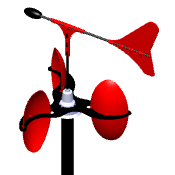How an Anemometer Can Improve Your Weather Surveillance System
How an Anemometer Can Improve Your Weather Surveillance System
Blog Article
All You Required to Know Concerning Anemometers: Exactly How They Function, Why They Issue, and Where to Make use of Them
Anemometers, though frequently forgotten in the realm of scientific instruments, play a critical role in different fields, providing useful understandings right into wind speed and airflow patterns. As we dig right into the intricacies of anemometer innovation, we will uncover the internal operations of these gadgets, their relevance, and the vital factors to consider when selecting the best anemometer for certain applications.

Anemometer Basics
A vital instrument utilized to gauge wind rate and direction, the anemometer plays an essential role in weather forecasting and different industries. An anemometer commonly is composed of three or four cups that revolve in the wind, a vane that aims right into the wind, and sensors to track the turnings or motions.
There are different sorts of anemometers readily available, including mug anemometers, vane anemometers, hot-wire anemometers, and sonic anemometers, each with its special functions and applications. Mug anemometers are typically made use of for fundamental wind speed measurements, while vane anemometers are preferred for directional dimensions. Hot-wire anemometers appropriate for low airspeeds, and sonic anemometers are ideal for high-precision dimensions in study and commercial setups. Understanding the fundamentals of anemometers is important for precise wind information collection and analysis across various fields.
Principles of Anemometer Procedure
Structure on the foundational understanding of anemometer essentials, the concepts of anemometer procedure illuminate the auto mechanics behind wind rate and instructions dimensions. Anemometers operate on the concept of air movement impacting a sensor, triggering it to revolve. Cup anemometers, for instance, have three or more cups that catch the wind, triggering them to rotate much faster as the wind rate rises. The turning speed is after that transformed right into a wind speed dimension. Vane anemometers, on the various other hand, make use of a tail or a probe that straightens itself with the wind instructions, giving a measurement of wind direction based upon the alignment of the sensing unit. Hot-wire anemometers depend on a warmed wire that cools down as wind overlooks it, with the price of cooling determining the wind speed. Ultrasonic anemometers action wind rate and instructions by examining the moment it considers ultrasonic signals to take a trip in between transducers. Understanding these principles is vital for exact and trusted Our site wind measurements in various applications.
Value of Anemometers
Anemometers play an important function in determining wind rate and instructions, giving necessary information for climate projecting, environment studies, environmental tracking, and air travel operations. Meteorologists rely on anemometers to gather precise wind data, aiding them recognize weather condition patterns, forecast storms, and concern prompt warnings to the public. Wind ranch operators use anemometers to examine wind conditions and take full advantage of power manufacturing from wind turbines.
Applications Throughout Different Industries
In the eco-friendly energy sector, anemometers play a crucial role in analyzing wind problems for wind ranch positionings, ensuring optimal energy production. Industries like building and mining utilize anemometers to check wind rates, critical for safety and security methods, specifically when working at elevations or in open-pit mines where solid winds can present risks. In agriculture, anemometers assist farmers in handling crop splashing by providing real-time data on wind speed to stay clear of drift.

Choosing the Right Anemometer for Your Requirements
Picking the ideal anemometer customized to your specific needs is vital for getting exact wind rate and direction dimensions. When picking an anemometer, consider factors such as the webpage designated application, called for measurement range, environmental conditions, and preferred features. For general purposes, a cup anemometer appropriates for determining wind rate, while a vane anemometer gives wind instructions information. Hot-wire anemometers are perfect for reduced airspeed measurements, and ultrasonic anemometers offer high accuracy and resilience.

Conclusion
Finally, anemometers play an important function in measuring wind rate and instructions across different sectors. Recognizing the concepts of anemometer procedure is necessary for selecting the best tool for particular requirements. From meteorology to aeronautics, anemometers are important tools for ensuring and gathering precise information security in different applications. When selecting the most ideal gadget for gauging wind problems., it is important to think about the value of anemometers in order to make educated choices.
There are different kinds of anemometers readily available, including mug anemometers, vane anemometers, hot-wire anemometers, and sonic anemometers, each with its one-of-a-kind functions and applications. Cup anemometers are frequently made use of for fundamental wind rate dimensions, while vane anemometers are favored for directional measurements. Hot-wire anemometers are ideal for reduced airspeeds, and sonic anemometers are ideal for high-precision measurements in research study and commercial settings.Structure on the fundamental understanding of anemometer essentials, the concepts of anemometer procedure clarify the auto mechanics behind wind speed and direction measurements. For general objectives, a mug anemometer is suitable for gauging wind rate, while a vane anemometer gives wind direction data.
Report this page